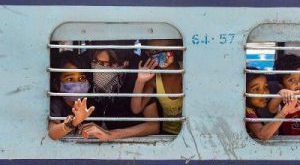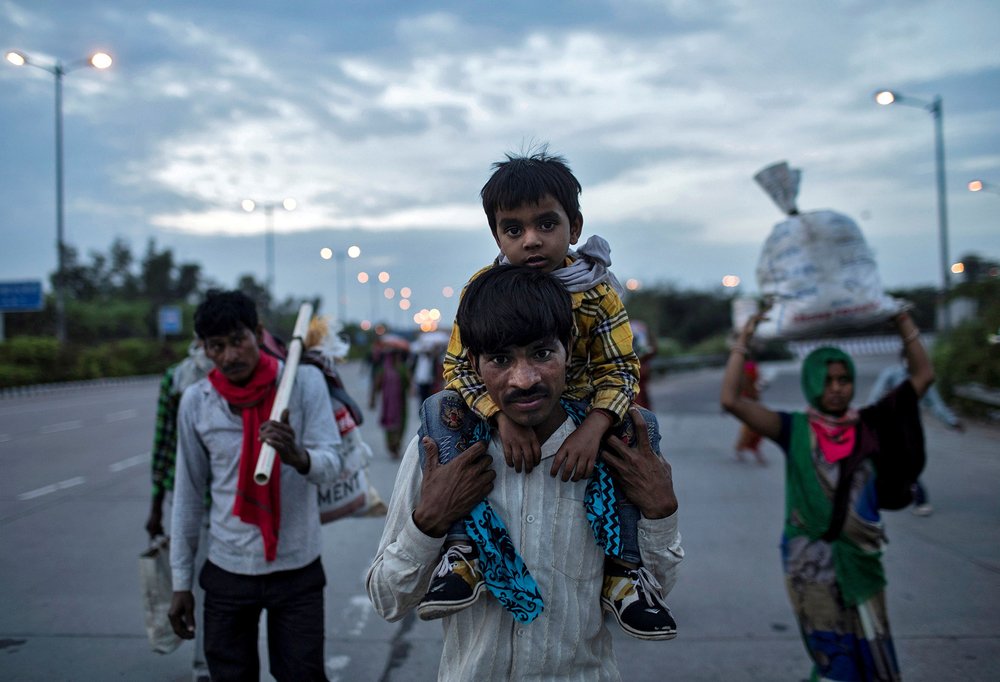
Citizens and the Sovereign: Stories from the largest exodus in contemporary Indian history – An overview

In this article, Sunil Tamminaina provides an overview of the key issues raised in the report Citizens and the Sovereign: Stories from the largest exodus in contemporary Indian history that he co-authored along with other members of the Migrant Workers Solidarity Network.

In a speech on 25 March 2020, the Indian Prime Minister Narendra Modi referred to the 21 day nation-wide lockdown he had announced a day earlier as a war. When supreme commanders make a declaration of war, they almost always focus exclusively on the enemy; the casualties that the war is inevitably going to produce, however, do not figure in such declarations. This absence does not necessarily mean that those who are vulnerable do not understand what war would entail to them.
The prospects of becoming war casualties dawned tragically on tens of millions of migrant workers in many cities across India.When Narendra Modi – the supreme commander of the nation, the sovereign put in place by the citizens through the means of electoral democracy – made that declaration of war ostensibly on the virus, the prospects of becoming war casualties dawned tragically on tens of millions of migrant workers in many cities across India. They spontaneously resolved to try and minimize the damage by going back to their home places, in whatever way possible, even if all forms of public transport had been stopped.
Several months later, the repercussion of the immense suffering that this mass migration caused are still felt in the large-scale loss of livelihoods.
This situation requires a critical evaluation of what led to the migrant worker crisis and demands to challenge the power structures that are responsible for migrant workers to continue living such precarious lives.
The recent report Citizens and the Sovereign: Stories from the largest exodus in contemporary Indian history by Migrant Workers Solidarity Network is an attempt in this direction. As part of relief efforts during the lockdown, members of the Network came in touch with many workers. The report includes testimonies of their experiences as well as in-depth interviews with workers rights’ activists from several parts of the country, who were actively involved in campaigning for migrant workers in their respective states during the lockdown.
Citizens and the Sovereign looks at the situation of the migrant working population in India and at their relationship with the State while also raising several key issues and challenges.
A crisis long overdue
The withdrawal of the State from its welfare responsibilities, and its role in facilitating capital’s expansion, has paved the way for maximization of profit.The growth of neoliberalism across much of the world has led to an elaborate network of production chains which are global in their spread. Instant mobility of global capital, made possible by the large scale financialization of the economy, helped create the conditions for building such global value chains. The availability of large pool of cheap labor, a necessity for such a system to flourish, is ensured through two parallel processes. The continuing “primitive accumulation” has dispossessed people of their land, forests and other resources. This, coupled with the devaluing of agriculture and traditional livelihoods, has left people with little choice but to migrate to urban areas to find new means of sustenance. Moreover, the erosion of workers’ protection structures and the greater informalization of work across the economy has allowed for capital to exploit labor on the cheap. The withdrawal of the State from its welfare responsibilities, and its role in facilitating capital’s expansion, has paved the way for maximization of profit. Such a transformation of the role of the State is near completion with the recent enactment of four labor codes by the Modi government. Effectively, these codes limit the State intervention in labor-capital relations by suppressing any labor unrest using the might of the criminal law.
In this backdrop of overwhelming dominance of neoliberal forces, the nature of work (and hence, the state of working people) has undergone substantive transformation over the past decades. The informalization of labor within the formal sector increased with a high proportion of the workforce being employed on contract basis. Employers are increasingly shedding off their legal responsibilities by using intermediaries and contractors to hire workers. At the macro level, work has become highly dispersed in character. Manufacturing in home-based establishments defined as “auxiliary units” as well as wide ranging self-employed units have become the norm. Although their output feeds into key nodes of global supply chains, workers in such units are not recognized as employees, depriving them of basic rights such as fair wages and social security.
Substantive citizenship rights for migrant workers like right to food, clean drinking water, sanitation, housing, etc. have rarely figured in public discourse.At the same time, labor chowks have mushroomed in major cities: each morning daily wage workers put themselves up for reverse auction to contractors in sectors such as construction. While cities grew – both in size and number – on the backs of migrant workers, providing them with a decent living has never been a serious priority for the State. Substantive citizenship rights for migrant workers like right to food, clean drinking water, sanitation, housing, etc. have rarely figured in public discourse. Cramped homes, often shared by two sets of workers living in separate “shifts” of the day — one set working while the other staying at home and vice versa to reduce the burden of rent — are part of everyday exploitative “normalcy” for migrant workers. The localities where they live also reflect how caste hierarchies are structurally reproduced within modern cities. Condemned to live in slums, which the State considers illegal, the perpetual threat of eviction only exacerbates their vulnerability. The stark contrast with the migrant workers who once settled in older industrial towns is highlighted in the words of Sumit Kumar, a Delhi-based trade unionist, in an interview for the report:
“The development of older industrial cities such as Jamshedpur, Bokaro and Bhilai attracted migrant workers who ultimately set roots there because of the social protections that they had won. A section of these migrant workers joined the ranks of the lower middle class. The kind of industrial development we have seen recently in northern and western India is very different. Despite having lived in places like Gurgaon, Faridabad, Dharuhera and Bawal for ten or fifteen years, they have remained ‘migrant workers’ because they have not been able to secure that kind of social security or permanent employment.” (Citizens and the Sovereign, p. 28)
Lockdown and beyond
With the working class already under siege, the announcement of the lockdown ended up deepening many existing contradictions within society. For migrant workers, who are used to a hand-to-mouth existence and little savings, the prospects of not finding work for several weeks (if not months) is a question of survival. The social networks in their native villages and towns, to which they return in time of crisis, are non-existent in the places they work. This lack of support triggered an incredibly hard mass reverse-migration.
With one of the most draconian lockdowns in the world, India turned into a virtual Police state and Police brutalities against workers were widely reported. Hundreds of migrant workers lost their lives due to starvation, financial distress and in accidents. Apart from the suffering for lack of money and food, workers faced acute stigma as they were treated as carriers of the virus. Even the concept of “social distancing” during the pandemic was fraught with dangerous implications in a country like India with deeply entrenched practices of caste based segregation. As the vast majority of migrant workers belong to already oppressed communities like Dalits, Adivasis and Muslims, discrimination surfaced in inhuman ways.
The growing dominance of Hindutva forces in recent years and a spate of mob lynchings — like that of Afrazul, a migrant worker from West Bengal lynched to death in Rajasthan in 2017 — created a climate of insecurity for workers from minority communities. This was exacerbated during the lockdown as the media actively stoked communal venom under the garb of covering the Tablighi Jamaat story. The report Citizens and the Sovereign describes how the Hindutva brigades blocked relief work in slums with substantial population of migrant workers from Muslim community (Citizens and the Sovereign, p. 53). Even before the lockdown, the native-migrant conflict was present, with migrants being considered outsiders who “steal” the locals’ jobs, an assumption that sometimes even leading to open violence against them. This latent conflict got exacerbated during the lockdown, with chauvinistic sub-nationalism showing its ugly face. For instance, the report narrates how a section of Kannada media defined “Bihari Bombs” some migrant workers who had tested positive to COVID in Bengaluru (Ibid., p. 57).
Despite so many adversities, workers fought back in many places through spontaneous protests during the lockdown, demanding that they should be provided with dignified shelter and food, and that the government make immediate arrangements for them to travel home. Many of these protests are documented in the Migrant Workers Resistance Map. While the demands raised in these protests are aimed at alleviating workers’ immediate distress, the structural factors that led to the crisis during the lockdown remain. Migrant workers also face specific challenges due to their high mobility, dispersed nature of work, and absence of social connections in the places they work. In this context, Citizens and the Sovereign underlies the need for a sustained struggle aimed at securing workplace rights as well as substantive citizenship rights for migrant workers.





